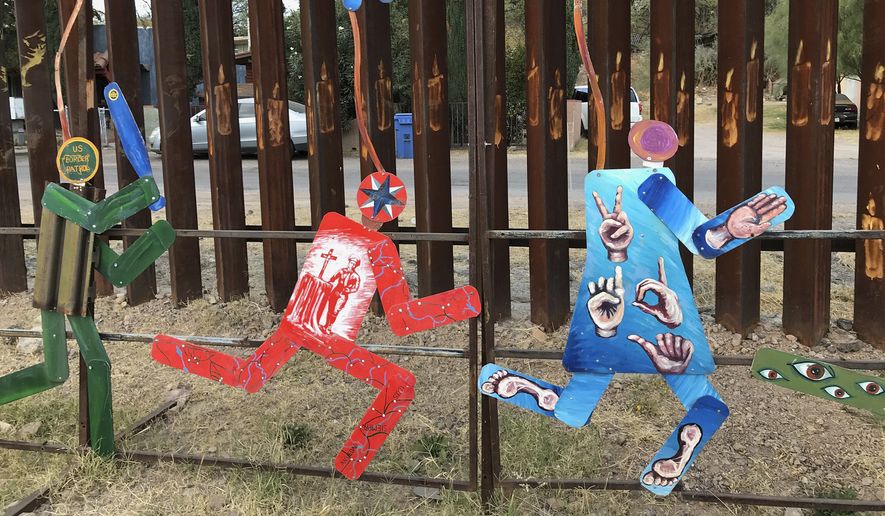Illegal border crossing tumbled to a 45-year low and interior arrests of illegal immigrants soared in 2017, according to data released Tuesday that showed President Trump’s enforcement crackdown netted tangible results during his first year on the job.
The numbers, released by the Department of Homeland Security, reflected a stunning turnaround from the nearly nonexistent interior enforcement of immigration laws under President Obama.
U.S. Customs and Border Protection reported 310,531 apprehensions nationwide in fiscal 2017, which ended Sept. 30, a decline of 25 percent from a year earlier and the lowest level since 1971.
Nearly all of the Border Patrol arrests — 303,916 — were along the southwestern border, which the agency said underscored the need for a security wall that Mr. Trump wants to build.
U.S. Immigration and Customs Enforcement agents, who are responsible for capturing and deporting illegal immigrants, made 110,568 arrests — a 40 percent increase from the previous year.
The agency said interior removals — people deported after being arrested away from the border — jumped 25 percent to 81,603.
“It shows probably the effectiveness of the Trump presidency and another success story as we wrap up the year,” said White House press secretary Sarah Huckabee Sanders. “The need for the border wall and border security, as well as responsible immigration reform, still stands. And we still need to look at all the ways that we can protect our national security. And we still feel strongly that [the wall] is one of them.”
Immigration analysts said the mere election of Mr. Trump dissuaded some border jumpers, but the effect could be diminishing. The number of illegal border crossers, mostly from Central America, has grown steadily since May.
The stronger interior enforcement began with John F. Kelly, the former homeland security secretary who now serves as Mr. Trump’s chief of staff. Mr. Kelly canceled Obama administration orders to deport only public safety threats, convicted criminals and recent border crossers.
He effectively revoked the free pass that the Obama administration gave illegal immigrants who had settled in the U.S. and made them vulnerable to deportation.
The success of Mr. Trump’s crackdown bolstered critics of his get-tough policies.
“I think we will fully secure our border when we give people a realistic legal option to come with a visa and not a smuggler, but the president and the Republicans are going in the opposite direction,” said Rep. Luis V. Gutierrez, an Illinois Democrat and prominent advocate for illegal immigrants. “They want to make it harder for people to come here legally and have proposed eliminating whole categories of legal immigration, which would benefit the smugglers tremendously.”
Chris Rickerd, policy counsel on border, immigration and voting issues for the American Civil Liberties Union, said record-low illegal crossings is the strongest argument yet against a border wall.
“Trump’s wall and more agents are dangerous, wasteful proposals that would be catastrophic for border communities. CBP should instead address its troubling track record of abuse by adopting reforms, like body-worn cameras, to increase transparency and accountability,” said Mr. Rickerd.
But Jessica M. Vaughan, the director of policy studies at the Center for Immigration Studies, a Washington think tank, said Mr. Trump’s policies were succeeding.
“It is that simple,” she said. “The Obama administration had a deliberate policy to restrict immigration enforcement to only the most egregious cases. We saw a decadeslong low, particularly in interior enforcement.”
The lack of enforcement enticed more people to cross the border illegally, but the Trump administration changed that calculation early on, said Ms. Vaughn.
“The other festering issue, of course, is sanctuary jurisdictions. Considering that the sanctuary policies are in place in some of the biggest cities where there are a lot of illegal aliens — in places like California — that ICE was able to increase interior removals by 25 percent, even though there were so many large cities and states trying to undermine their efforts, is remarkable.”
Acting Homeland Security Secretary Elaine Duke credited Mr. Trump, who made fighting illegal immigration a cornerstone of his campaign and a top priority when he took office in January.
“We have clearly seen the successful results of the president’s commitment to supporting the front-line officers and agents of DHS as they enforce the law and secure our borders,” she said. “We have an obligation to uphold the integrity of our immigration system, but we must do more to step up and close loopholes to protect the American worker, our economy and our communities.”
However, the advances by the Trump administration barely dented the estimated population of 12.5 million illegal immigrants in the U.S.
U.S. Customs and Border Protection also voiced continued concerned about a steady increase in the flow of unaccompanied children and families from Central America, as transnational criminal organizations continue to exploit legal and policy loopholes to help illegal aliens gain entry and get released into the interior of the country.
About 58 percent of Border Patrol arrests were people from countries other than Mexico — up from 54 percent from a year earlier — largely from Central America. Starting around 2011, large numbers from El Salvador, Guatemala and Honduras began entering the country in South Texas, which replaced Arizona as the busiest corridor for illegal crossings.
• S.A. Miller can be reached at smiller@washingtontimes.com.




Please read our comment policy before commenting.